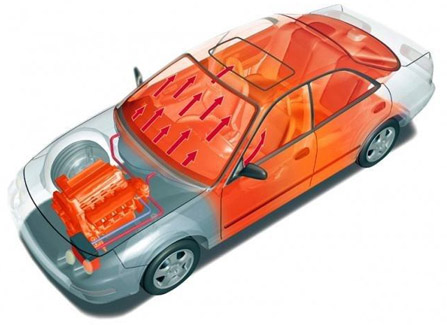Additional heating system in the car.
 The additional heating system in the car only seemingly seems to be a device that only affects the comfort of driving. In addition, undoubtedly an important task is also to fulfill functions important from the point of view of preventive and active safety. Thickly dressed, yet still cold, the driver will have limited freedom of movement, and more than on the road ahead, he will focus on his own, not well-being. And even if you have a minimum of concentration, icy and foggy windows will make it difficult for him. Meanwhile, during the cold winter, a standard heating and ventilation system, drawing heat from the engine cooling system, it may turn out to be too inefficient, to ensure the correct temperature in the cabin and good visibility. Additional heating can provide heat not only to the cabin or the cargo compartment, but also for the engine cooling system.
The additional heating system in the car only seemingly seems to be a device that only affects the comfort of driving. In addition, undoubtedly an important task is also to fulfill functions important from the point of view of preventive and active safety. Thickly dressed, yet still cold, the driver will have limited freedom of movement, and more than on the road ahead, he will focus on his own, not well-being. And even if you have a minimum of concentration, icy and foggy windows will make it difficult for him. Meanwhile, during the cold winter, a standard heating and ventilation system, drawing heat from the engine cooling system, it may turn out to be too inefficient, to ensure the correct temperature in the cabin and good visibility. Additional heating can provide heat not only to the cabin or the cargo compartment, but also for the engine cooling system.
Additional heating devices, unlike the factory ones, they work independently of the engine. They run on petrol or diesel fuel, taken from the main or own fuel tank and burned in a special combustion chamber. The medium circulating in the circuit and transferring heat is either water or air. In the first case (water heating) the cooling system of the drive unit is used. Electric pump, powered by rechargeable battery, forces the liquid to the heat exchanger, and the blower blows heated air into the vehicle interior. The unit is then installed in the engine compartment. The advantage of this solution is also the possibility of heating the drive unit, which makes winter start-up easier.
Air heating works directly and much faster than water heating. It draws in air from the environment and, after being heated in the exchanger, passes it to the cabin or the hold. The device is installed either directly in the heated space, or under the floor, or in the trunk of the car. Installation voltage may be 12 the 24 V, power from 850 do 5000 W, if an electric heater is used.
Water heating is mainly used in passenger vehicles, vans, off-road, minivans and minibuses. Air heating is also suitable for motorhomes, workshop, specialized, ambulances, etc., as well as for the protection of cargo sensitive to low temperatures (computers, medicines, Pets, cosmetics, etc.). This system is not used to warm the engine in winter.
Independent heating systems can function both while driving and when stationary. Thanks to electronic control systems, the temperature can be regulated (np. in the range of 10-30 ° C) by grading the heating power, program the switch-on time (with an accuracy of up to 1 min) and time of action (np. from 10 do 120 min), as well as run the installation remotely (from a distance of approx. 1000 m). In countries with cold climates, additional heating is sometimes offered when the car is purchased. Some producers (Audi, Volkswagen) they also install the so-called. additional heaters to compensate for the heat deficit, formed in winter in modern diesel engines as a result of their economical operation (low heat losses, low self-friction). In turn, devices that "store" heat from the cooling system – so-called. heat accumulators, developed by BMW and Saab – keep the engine in winter at a temperature above 0 ° C for several hours, which facilitates starting at low temperatures.